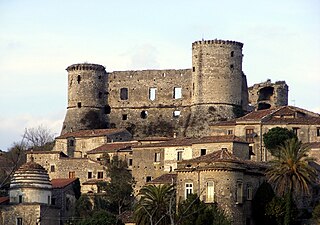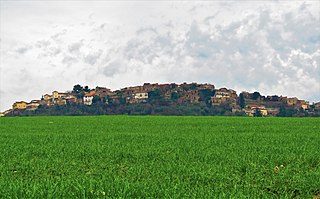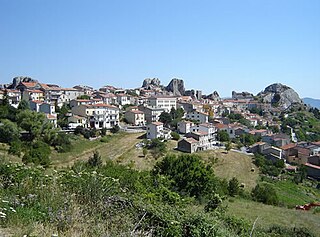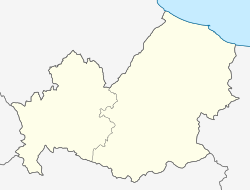
Isernia is a town and comune in the southern Italian region of Molise, and the capital of province of Isernia.

Acerra is a town and comune of Campania, southern Italy, in the Metropolitan City of Naples, about 15 kilometres northeast of the capital in Naples. It is part of the Agro Acerrano plain.

Melfi is a town and comune in the Vulture area of the province of Potenza, in the Southern Italian region of Basilicata. Geographically, it is midway between Naples and Bari. In 2015 it had a population of 17,768.

Mirabello Sannitico is a small town in the province of Campobasso, Molise, southern Italy. The population is about 2,100 inhabitants. It has anagrarian-based culture and history, dating back to at least the 12th century. Nearby towns include Campobasso to the northwest and Vinchiaturo to the southwest. The Tappino River flows on either side of the town on the north and south.

Telese Terme, called simply Telese until 1991, is a city, comune (municipality) and former episcopal seat in the Province of Benevento, in the Campania region of southern Italy. It is located in the valley of the Calore, well known for its sulfuric hot springs.

Alife is a town and comune in the Province of Caserta (Campania), Italy. It is located in the Volturno valley, and is a flourishing centre of agricultural production.

Cantalupo nel Sannio is a town and comune in the province of Isernia, in the Molise region of southern Italy.

Sant'Angelo dei Lombardi is a town and comune in the province of Avellino in the Campania region of southern Italy. It has been a historical spot of significance in mezzogiorno history.

Alfedena is a comune in the province of L'Aquila of the Abruzzo region of central Italy. It is located in the Abruzzo, Lazio and Molise National Park in the upper Sangro valley, near the Monti della Meta mountain chain.

Guardiaregia is a small mountain town in the Province of Campobasso, Molise, southern Italy. Their patron saint is San Nicola di Bari, otherwise known as St. Nicholas.

Vairano Patenora is a comune (municipality) in the Province of Caserta in the Italian region Campania, located about 60 kilometres (37 mi) north of Naples and about 35 kilometres (22 mi) northwest of Caserta.

Morcone is a comune (municipality) in the Province of Benevento in the Italian region Campania, located about 70 km northeast of Naples and about 25 km northwest of Benevento. The villages (Contrade) of Morcone include: Canepino, Cuffiano, Coste, Torre, Fuschi, Piana.

Paduli is a comune (municipality) in the Province of Benevento in the Italian region Campania. It is located on a rocky spur between the Calore and Tammaro rivers, about 60 km northeast of Naples and about 9 km northeast of Benevento.

San Salvatore Telesino is a comune (municipality) in the Province of Benevento in the Italian region Campania, located about 50 kilometres (31 mi) northeast of Naples and about 25 kilometres (16 mi) northwest of Benevento.

San Massimo is a comune (municipality) in the Province of Campobasso in the Italian region Molise, located about 25 kilometres (16 mi) southwest of Campobasso, comprising 27.6 square kilometres (10.7 sq mi).

Sepino is a comune (municipality) in the Province of Campobasso in the Italian region Molise, located about 20 kilometres (12 mi) south of Campobasso.

Pietrabbondante is a comune (municipality) in the Province of Isernia in the Italian region Molise, located about 30 kilometres (19 mi) northwest of Campobasso and about 20 kilometres (12 mi) northeast of Isernia.

Irpinia is a geographical and cultural region of Southern Italy. It was the inland territory of the ancient Hirpini tribe, and its extent matches approximately today's province of Avellino.

The Bulgarians in Italy are one of the sizable communities of the Bulgarian diaspora in Western Europe. There are about 120,000 Bulgarians in Italy according to the Bulgarian government. There are Bulgarian Orthodox parishes in Rome and Milan. Major centres of Bulgarian migration are Milan, Bologna, Florence and Torino.

Old Great Bulgaria or Great Bulgaria, also often known by the Latin names Magna Bulgaria and Patria Onoguria, was a 7th-century Nomadic empire formed by the Onogur Bulgars on the western Pontic–Caspian steppe. Great Bulgaria was originally centered between the Dniester and lower Volga.





















